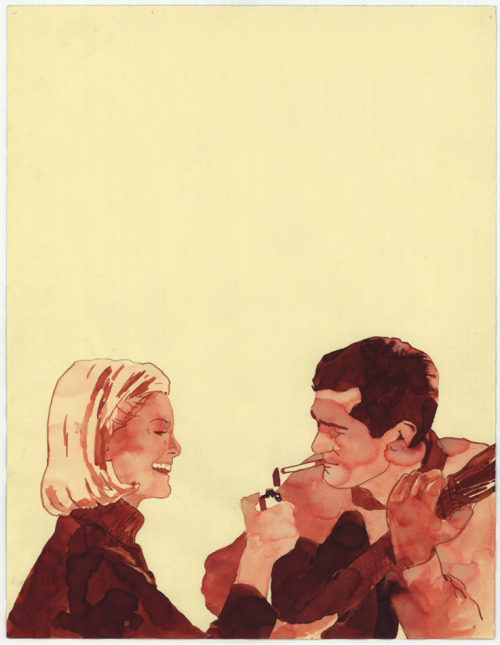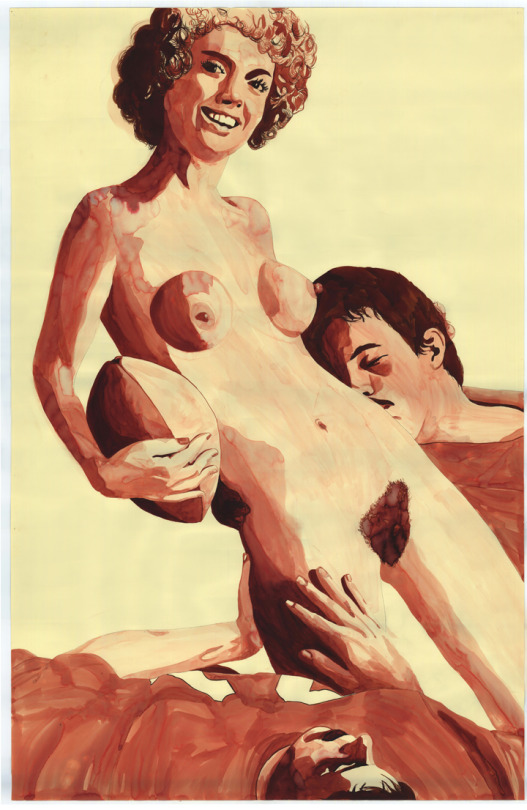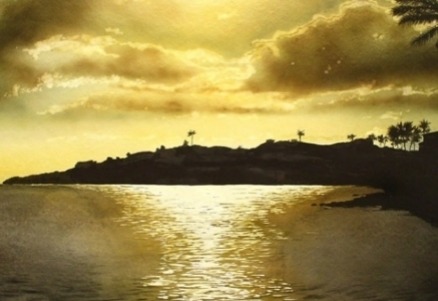Dikeou Collection Program Recap: Video Dialogue Series
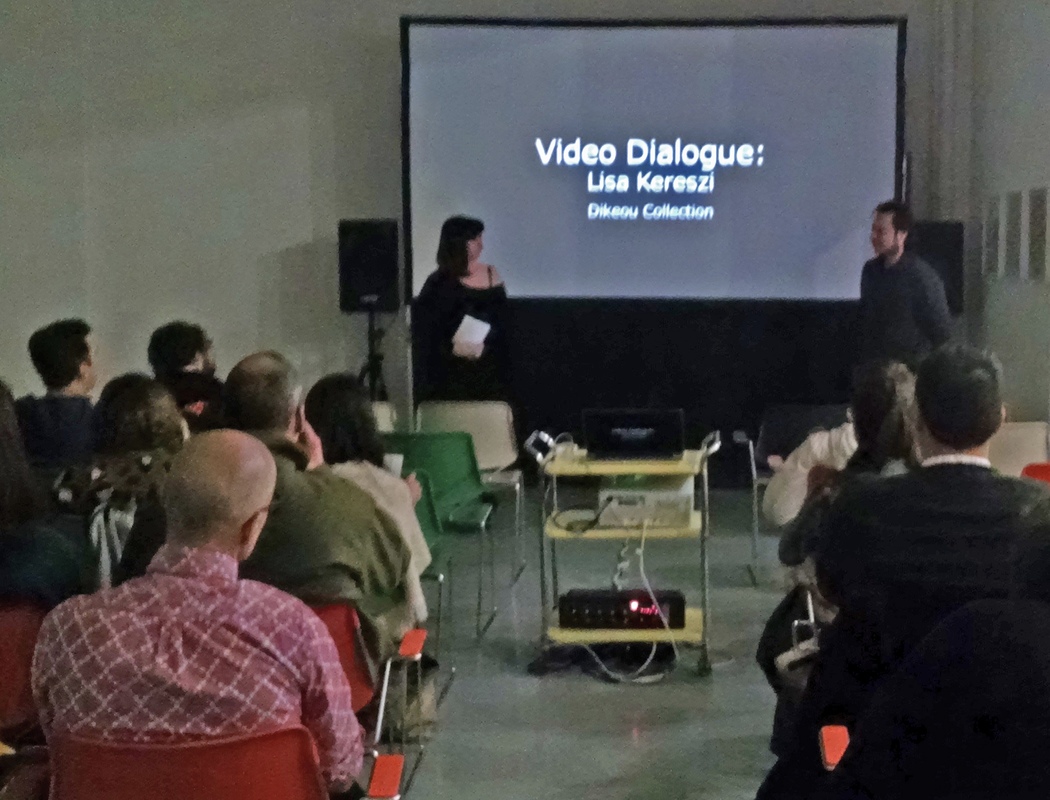
Lisa Kereszi: Video Dialogue Screening
As a permanent, non-rotating, contemporary art collection, we are always working to engage our audiences with artworks or artists that they may already be very familiar with. In July of 2015, Saniego Sanchez and Jenna Maurice created and launched the Video Dialogue Series, a monthly video screening. The Video Dialogue Series is a program that focuses on one artwork/artist in the Dikeou Collection and uses videos to explore tangential connections to expand the conversation around the selected artwork/artist. Each screening features one hour of video clips assembled from common and unconventional sources and thus serves as an unofficial video conversation about the artwork/artist. So far, Sanchez and Maurice have created six of these Video Dialogues focusing on artists Chris Johanson, Momoyo Torimitsu, Giasco Bertoli, Lisa Kereszi, Sarah Staton and most recently, Devon Dikeou. Looking to the artist’s inspiration, contemporaneous art movements, location, or their own dialogue about the work, the Video Dialogue Series is able to carry both a light-hearted and a serious approach to discussions surrounding the artwork in the collection.
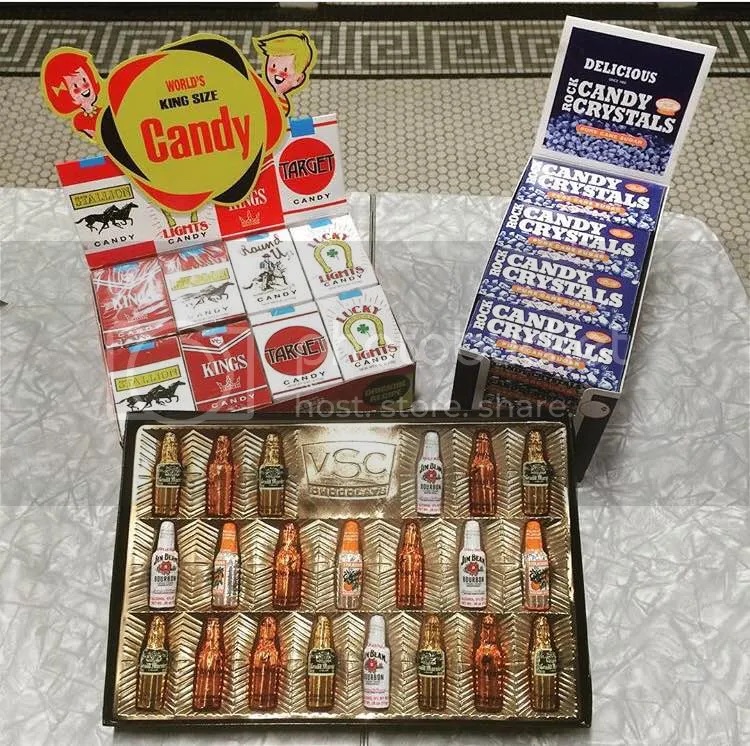
Each screening begins with specific information about the artist/artwork featured. This introduction can either be the artist statement, or a video clip documenting the artwork and a localized conversation about it. From there, the selected videos range from advertisements, to conversations about similar artists. As customary to such varied presentations, there is a handheld program provided for the potential eager audience member, or more importantly for reference if they want to re-watch a clip or the entire hour-long series. Not only does the Video Dialogue provide an alternative visual and audio guide to explore the artwork, but the food and drink provided at the screening corresponds with the theme to extend the dialogue and to engage a more sensory experience.

Lisa Kereszi’s Video Dialogue Program
Lisa Kereszi’s Video Dialogue on November 4, 2015, addressed addictive substances. In her photo series at the collection, Kereszi frames various social situations in which her friends are engaged in party-like scenes smoking and drinking. But there is also a lingering sense of hostility, tension, and frustration in what seem to be happy party-goers enjoying themselves. The minimal separation of enjoyment and potential danger is especially clear in Kereszi’s photo entitled Jack With Jim Beam, where a revolver is foregrounded with a bottle of whiskey. Inspired by Kereszi’s photography, this Video Dialogue focused on the various ways society views addictive substances and how these views have changed dramatically over time. The food provided at the screening included candy cigarettes, alcoholic chocolate and sugar crystals (in the shape of crack rocks). Clips included cigarette and alcohol ads that promoted the use of these legalized, government endorsed addictive products but other clips warned against the addictive use of substances considered “drugs.” As the categorical line between drugs and legalized substances thins out, the audience is able to recognize the classist and racist use of deception and hypocrisy when it comes to what is considered socially acceptable addiction. The end of the screening included a little bonus cartoon titled “Life Smartphone” about a society-wide addictive behavior, as we are all glued to our cell phones. In the video, characters are only engaging with their cell phones, taking selfies and texting, all the while the world is crumbling around them and they have no idea. Here is a link to the preview of the screening so you can get a little sniff for yourself https://vimeo.com/145013121.
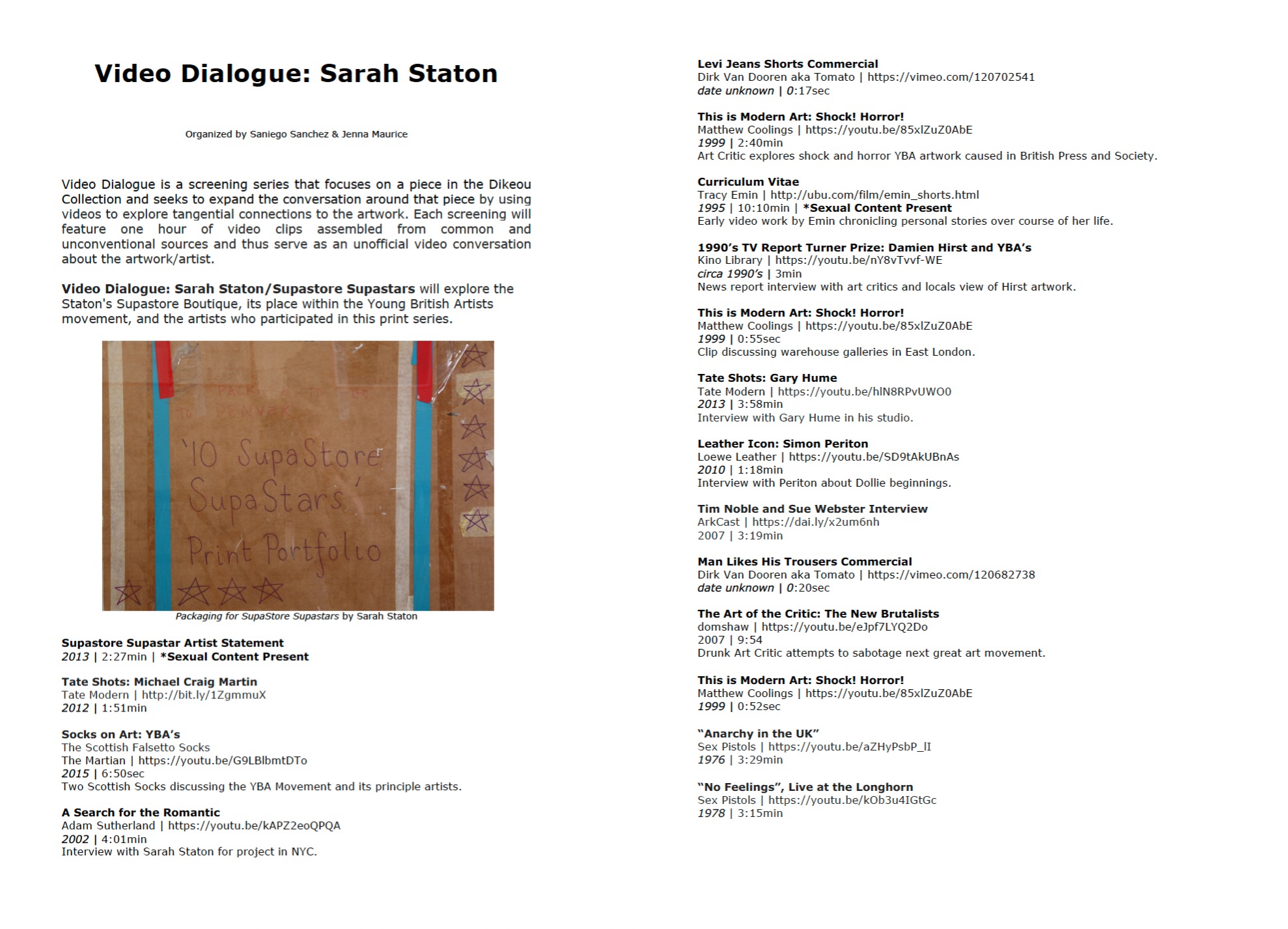
Sarah Staton’s Video Dialogue Program
Sarah Staton’s Video Dialogue on December 18, 2015, focused on the Young British Artist (YBA) movement, Sarah Staton’s Supastore and contemporary viewpoints on the work and ethics of the YBA’s collective actions and creations. Touching on the com-modified and material economy of the art world, through her Supastore, Staton created a parody of department stores in which the audience would navigate their way through a traveling store’s drawers to find portfolios, cigarettes, or even credit cards. The portfolio in the collection from the Supastore titled 10 Supastore Supastars, includes a print series of one work from ten different artists. Staton’s Supastore featured artists in a unique exhibition space and art market, challenging the gallery and its stagnancy. The Video Dialogue informed the audience about the multidimensional ways in which the YBAs engaged their practice into their daily life such as Tracy Emin’s 1995 work, “Curriculum Vitae.” The Video Dialogue also addressed the ways in which the movement was critiqued. In a clip entitled “The Art of the Critic: The New Brutalists” an art critic follows around potential art buyers and makes fun of the artwork seen in the studios, putting off the buyers and thus sabotaging the next great art movement. The clips in this screening varied in topic, but each seemed to point directly to the YBA movement as a form of shock art, showing how they are simultaneously oppositional and entrepreneurial. Eating fish n’ chips, Cadbury Flakes and Turkish Delights while washing it down with Ribena and Old English 40s, the audience seemed to enjoy the multifaceted ways in which the YBA movement worked its way into the contemporary American art world by first contextualizing spaces and artworks back in England while critiquing or disrupting the global art market in a beneficial way. The preview for Staton’s screening can be found here https://vimeo.com/144802406.
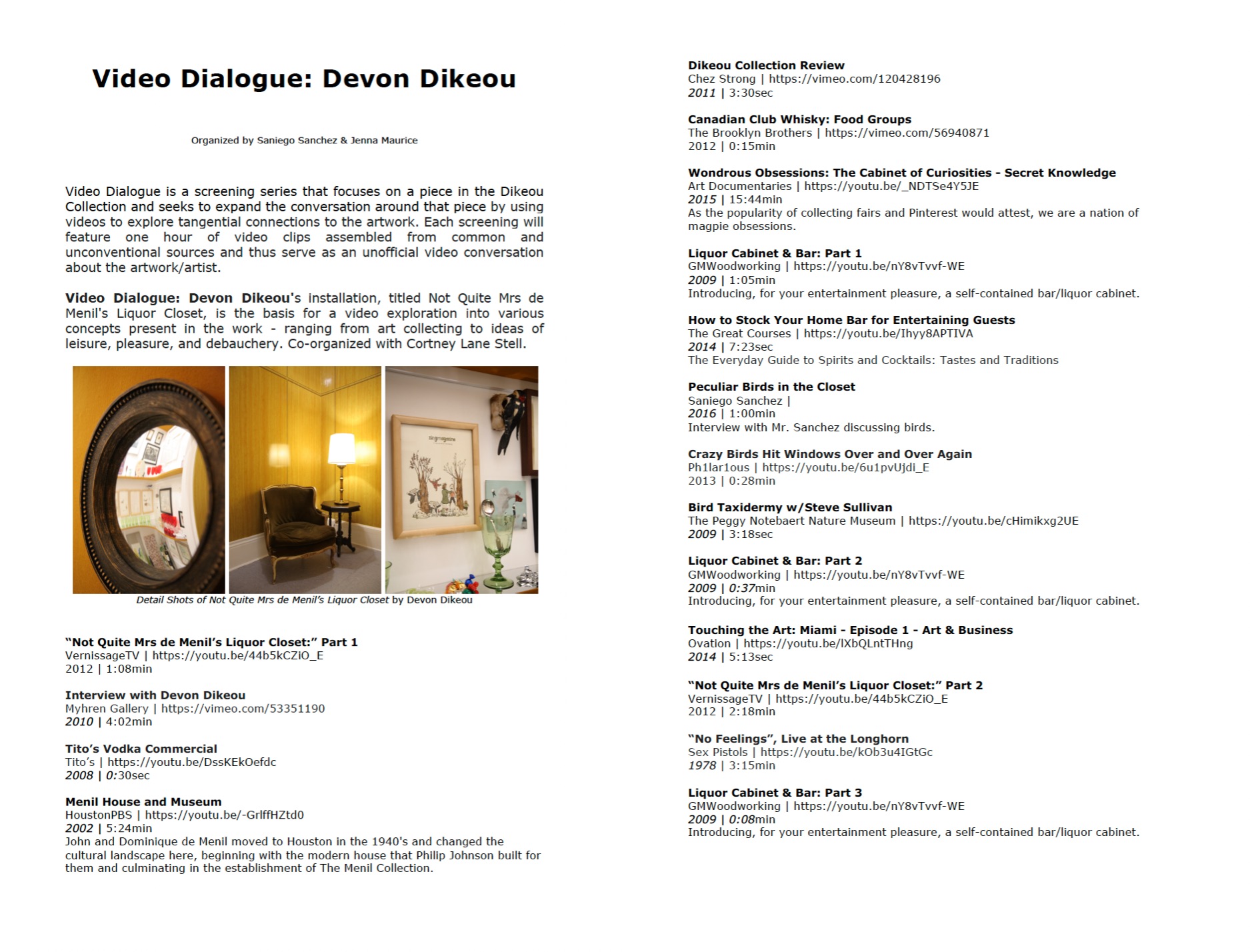
Devon Dikeou’s Video Dialogue Program
The most recent screening of the Video Dialogue Series at the collection, highlighted Artist, Editor and Curator, Devon Dikeou and focused on her piece titled Not Quite Mrs. de Menil’s Liquor Closet. Looking at the connections between cabinets of curiosities and birds flying into the windows at Mrs. de Menil’s house, the audience was informed about Devon’s interests, practice and relationships to her fellow contemporary artists. Information about how to properly taxidermy a bird, mix a cocktail, and advertisements for portable liquor cabinets guided the audience on a Bud Light flavored path to better understanding her practice and specific use of space and other’s artwork in this installation. The clips also historically contextualized the practice of collecting small, foreign objects into cabinets of curiosities, while relating them to Mrs. de Menil’s actual liquor closet and home in the clip “Menil House and Museum.” Clips in the Video Dialogue connected these two temporally disparate art collectors to their various objects and methods of display. Even more so, the Video Dialogue gave an illuminating glimpse into Devon Dikeou’s intermingling of art collecting with her own art practice. As these works were either gifts or trades, none purchased, the audience can better understand Devon’s own relationship with the artists whose work she collects. Bar food like White Castle burgers, truffle popcorn, mixed nuts and vending machine candy were provided to compliment all of the liquor and taxidermy talk on the screen. Devon Dikeou’s preview can be found here https://vimeo.com/145013478.
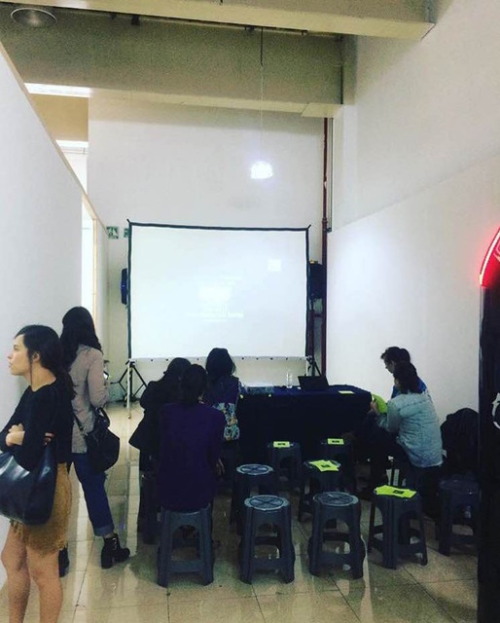
Video Dialogue Screening at Material Art Fair

